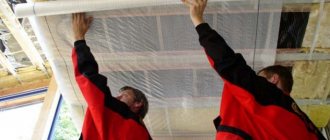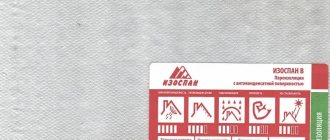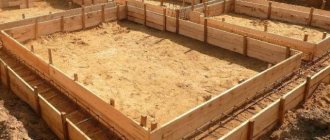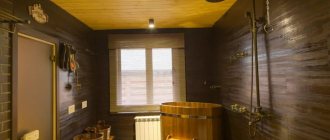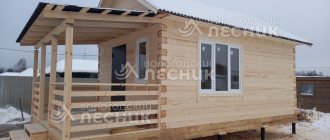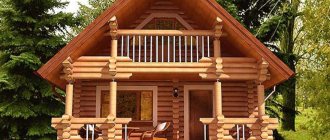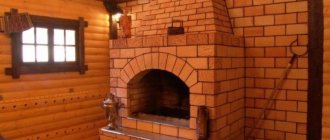From the author: Hello again, my dear readers! Today I would like to pay attention to the question of what kind of mortar the fireclay brick is placed on, and why it is needed in general. In itself, it is a peculiar mixture of fireclay powder and refractory clay. This synthesis of materials allows it to withstand temperatures of up to one and a half thousand degrees Celsius, but more on the benefits later.
More than once in my practice I have seen how a huge stove was built, which was used as a barbecue or grill, and the wrong connector was used during its installation. It did not have the same fire-resistant qualities, which led to the complete destruction of the entire structure. Naturally, the brick also deteriorated, which led to the largest possible loss of the client’s financial resources.
Now I will tell you how to make high-quality masonry mortar correctly and with your own hands, without the help of professionals.
Characteristics of refractory bricks
There are a lot of fakes of this type of stone on the modern Internet. In this regard, I immediately want to protect you and advise you to purchase it only in specialized stores, construction hypermarkets or other places where you can touch it and evaluate the quality.
The first thing you need to know is that it must be beige in color. The shade should not be faded or, conversely, saturated, this indicates a marriage or deception. Each brick weighs approximately three kilograms. The material must not have cavities or any other openings. The ingress of air can lead to a decrease in heat resistance and, therefore, lead to unusability of the product. The dimensions of the standard sample do not exceed 25 centimeters in length, 12 in width and 6.5 in height.
Unfortunately, you won’t be able to check his abilities in the store, so at least ask the seller for information on this issue. If he answers that the fireclay brick they provide for sale has high heat resistance and low thermal conductivity, then you can easily give preference to the type of material under discussion. This is exactly the product you need.
Source: teploguru.ru
Main types
Many manufacturers met customers halfway and began producing fireclay stone of various types, differing in shape, weight and size, as well as manufacturing technologies and degree of porosity. Today, the following forms of fireclay are presented on the construction market:
- straight;
- arched;
- trapezoidal;
- wedge-shaped.
Thanks to this variety of forms, it became possible to erect structures with complex structures.
The following types of fireclay stone with different percentages of porosity are distinguished:
- ultra-lightweight (more than 85%);
- lightweight (45-85%);
- increased porosity (30-45%);
- medium-dense (20-30%);
- compacted (16-20%);
- dense (10-16%);
- high-density (3-10%);
- especially dense (less than 3%).
Such qualities make it possible to understand which brand is best to choose for the construction of specific structures.
As for the method of forming bricks, the following options are distinguished:
- fused;
- cast;
- hot pressed;
- thermoplastic extruded;
- molded using the plastic or semi-dry method.
Technologists at large factories continue to develop new product options. They add new components to the composition that improve its quality. In addition, production technology is improving, which makes it possible to obtain products with unusual properties. Thus, fireclay appeared, which has the ability to withstand extremely low temperatures.
Cases in which this will be useful to you
In most cases, the need for heat-resistant bricks arises among owners of private houses or summer cottages. Apartment residents do not need it, since fire safety regulations prohibit you from creating an uncontrolled open fire on the territory of a residential building. Alas, building a barbecue on a balcony or loggia is not the best idea.
This type of stone will serve you well when constructing stoves for heating a house, a chimney used for the same purpose, a permanent installation for a grill, or when planning an English fireplace that will show off on the central wall of your future home. It will create comfort and coziness for you, which will add warm and bright colors to your vacation. In addition to all this, don’t forget that on New Year’s Day you will have somewhere to hang festive socks so that Santa Claus will put sweets in them for your children.
It is not worth saving on material, because the quality directly depends on the price, and since buildings made of fireclay bricks are not cheap, their reconstruction will cost a lot of money.
The solution recipe that I will now tell you can also be used for repair work. It is quite possible that one stone may fall off inside the structure, which needs to be put in place using just such a mixture.
How to choose quality products?
In some cases, a darker color predominates on the surface. At the same time, it is covered with a smooth glass film. This is caused by the fireclay being overexposed during firing in the kiln. Burnt bricks have great strength, but due to the smooth surface there is no high-quality adhesion to the mortar, as a result of which the finished structure turns out to be fragile. However, such bricks can be used when constructing a foundation.
Only high-quality products have the above qualities. If the production technology is disrupted, the finished brick will lose about 75% of its positive qualities. For this reason, it is necessary to know the main differences between high-quality fireclay and be able to recognize them at the time of purchase. A brick made using fireclay powder should have a geometrically correct shape and have thin edges. The surface should be slightly rough, with a clearly visible granular structure.
If you knock on a well-fired brick, it will make a metallic and ringing sound. During the fall, it will not crumble into dust, but will break up into large elements. If a brick crumbles when it falls and a dull sound is heard upon impact, you have an insufficiently fired brick. The problems of this material will be increased hygroscopicity, low strength and insufficient thermal conductivity.
What solutions are strictly prohibited to use?
The overwhelming majority of ordinary people, who are trying to prove to everyone that they know more than others, argue that the basis of a viscous creature does not matter at all when laying structures that will be exposed to high temperatures. I hasten to protect you from the crazy thoughts of these savages and prove the opposite.
Source: jacekpartyka.com
These pseudo-builders claim that ordinary cement mortar, which we are accustomed to using when laying ordinary walls, will serve perfectly for many years. I can prove the opposite using mathematics and physics. Look here.
The melting point of cement is one and a half thousand degrees Celsius. This is the phase at which solid, one might say, concrete begins to turn into a viscous solution. The burning of wood produces thermometer readings at one thousand degrees Celsius. That is, we can safely say that this type of binder will be destroyed after a couple of hours of creating heat inside the room, and you definitely won’t get the long-awaited barbecue for May Day.
There is nothing to say about lime analogues, because the rates at which they turn into a liquid state are even lower.
Required Tools
Brickwork is impossible without auxiliary tools. They are divided into two categories: control and operational.
Control tools are needed to ensure that the masonry lays evenly and correctly.
Plumb. Structurally simple, but important thing for controlling vertical surfaces of masonry: walls, piers, pillars, corners. The plumb line looks like a strong cord with a sinker at one end. The weight of the sinker can be small (200–400 g) to control verticality at the level of one floor.
- Mooring. This is a thick thread or twisted cord 1–3 mm thick. The mooring is stretched between the beacon corners so that the rows of masonry are even along a horizontal line. It ensures the same thickness of the mortar joint and a clear horizontal line. One thread is not enough for mooring - you need a homemade weight to keep the thread taut, and a nail 3-4 mm thick. Half a brick wrapped in paper and a bag with handles (to tie up the ends of the mooring) are suitable as a load. A nail is needed to secure the thread between the bricks.
- Rule. This tool looks like a spatula with a blade length of about 100 cm or an aluminum strip up to 150 cm long. The rule is needed to check the front side of the masonry. It should be as smooth as possible.
- Order. This is a wooden strip with markings for a standard brick and a standard joint 1.2 cm thick. The strip has divisions with a distance of every 77 and 100 mm (brick thickness + joint thickness). With its help, rows, window and door openings, ceilings and lintels are marked.
- Bar. Auxiliary metal profile of various shapes. It is made of thin stainless metal and helps to make corners and openings smooth. The rod remains inside the masonry, unlike the mooring, which moves upward from row to row.
Working tools are the necessary basis for DIY masonry.
- Trowel. This is a small spatula with a wooden handle and a polished steel working surface. The steel part is varied in shape and size (drop-shaped, triangular, rectangular). Typically, it has a wide base and a tapering tip. A trowel is needed to level the mortar on the seams. It is also used to fill vertical seams and cut off excess mortar.
- Mortar shovel. The name of the tool already informs about its functions - stir the solution in a container and apply it to the seam.
- Joining. This small tool is needed to give the seam a certain shape. The jointing can be convex and concave for protruding and “recessed” seams.
- Hammer-pick. This is a hammer with a pointed end on one side and a flat part on the other. With its help, the brick is divided into parts when necessary.
- Mopping. A tool with a metal handle and a square rubber plate at the base. The location of the rubber is horizontal. Mopping is needed to smooth and fill the seams inside the ventilation ducts. It is also used to remove excess solution from the ventilation ducts.
In addition to the two main categories of tools, you also need auxiliary ones: containers for solution and water, cement and sand, gloves, and a safety kit for working at height.
So what to do?
For laying fireclay bricks, a special clay mortar is used. Many of you have heard about it, some have seen it, and only a few have worked with it. Therefore, I will tell you about its features.
I recommend using so-called fatty samples of this type of mixture, since when they dry, they only crack a little. There is no escape from this, because you will not be able to achieve the most acceptable consistency. There is no standard in this matter, and we can only endlessly try to get closer to the ideal.
Source: dizainvsadu.ru
The clay should not be ordinary clay, which you found on the lake near your parents’ house, but fire-resistant. Even in ancient times, dishes like this were used to make dishes that hardened during heat treatment in the oven. It is light brown in color and quite hard in its normal state. Before purchasing, consult with friends who have encountered a similar problem about the place of purchase, so as not to end up with low-quality raw materials.
A little higher, I recalled well-wishers who do not have the slightest idea about this issue. Several times I came across articles in which it was written that a chimney can be made using standard solutions. This is true, but not all of it, but only its upper part. At a distance of one and a half meters from the place where the fire is concentrated, everything should be treated with a clay look. I'll talk about the consequences a little later.
Quality of clay and sand
To create a high-quality solution, you should choose very fine sand. In addition, it must be clean. The sand is sifted through a fine sieve to remove pebbles and plant debris. To understand whether the clay is suitable for work, you need to feel it. However, this method is only suitable for experienced professionals. Beginners use a different method.
To understand what quality the clay is, you need to put it in a bucket and fill it with water. Afterwards the clay is mixed. As a result, it turns out similar to sour cream. Until the clay begins to settle, a freshly planed wooden plank should be lowered into the bucket. Then it is taken out of the solution and examined. There should be some clay left on the board. If this layer is less than 1 mm, the clay is thin. It must be mixed with clays of higher fat content. When the layer turns out to be quite thick, you need to add sand. Clay with normal plasticity will adhere unevenly to the board, and the layer will be 2 mm.
A rather lengthy method for determining the quality of clay is to divide it into five portions. Each should have a volume of one liter. The first portion should be mixed with water. To the second you need to add 1/10 of a liter container of sand. In the third you need to put ¼ of the jar. The fourth portion should contain 3/4, and the last - a liter of sand.
As a result of mixing the components of the solution, it is necessary to bring it to such a state that the clay stops sticking to your hands. From all the mixtures you need to make balls and roll them into flat cakes. The drying time for clay indoors is approximately 10 days. The composition that cracks less than the others is suitable for use. The balls should not break when falling from a height of 1 m onto a hard floor.
If you don’t have time, you can put the balls on the table and press them down with a flat board. If the balls crumble immediately, it means they are made of thin clay. Oily clay manifests itself as an almost complete absence of cracks. It is better to choose the composition from which the ball is covered with small cracks by 1/3 of the size of the product.
Production of a specialized mixture
To form a clay solution you will need three required components:
- fire-clay,
- sand. It is this that is an excellent leavening agent and is used in all such batches,
- water. There is a popular belief that to achieve maximum quality, it is best to use rainwater. I have never tried this, because I think that in the twenty-first century, collecting rain is at least a little wild. However, I also cannot say that there is no difference. In general, as for me, ordinary water that flows from the tap is enough.
When synthesizing, you should remember simple proportions. Clay and sand are poured in a one to one ratio and mixed thoroughly to create a homogeneous mass. Only after this is it possible to add liquid to achieve the desired level of viscosity of the substance. It costs about one-fourth to pour the volume that you have already mixed. The consistency should resemble sour cream. In this case, you will get a high-quality result.
If you decide to collect rainwater, write in the comments under this article or on our social media pages about the results. Is it really better?
Flaws
- Fireclay brick blocks, due to their high strength, are extremely difficult to cut;
- very high cost;
- installation requires a special solution;
- The laying of fireclay brick structures must be carried out exclusively by a highly qualified specialist.
Methods of application, installation methods, possible options for structures built from fireclay bricks are shown in photo and video materials. Excellent reviews from both builders and customers who have experience in the operation and use of fireclay brick structures make it an indispensable material in the construction of various objects and structures.
Possible consequences
Certain errors, of course, are acceptable, but a disregard for the production of a special heat-resistant solution leads to catastrophic consequences. Improper mixing can cause severe cracks or complete looseness of the brick-to-brick connector. Subsequently, you will see how the entire structure deforms and collapses right before your eyes.
Quite a large number of owners of stoves, pipes, barbecues and grills, built by irresponsible, disgusting craftsmen, asked for help. But all we could do was disassemble and reassemble the entire structure.
It was unbearably painful to see the look of a man who had already marinated the meat and realized that he would have to fry it over a regular fire. It became even worse at the moment when he turned his head, and part of the chimney collapsed inside the built fireplace. It was doubly offensive because it was not Santa Claus who broke it.
Advantages
- increased strength;
- high fire resistance;
- high heat capacity;
- sufficient resistance to various types of negative environmental influences;
- the possibility of trouble-free operation without deformation and wear for many years;
- Thanks to the smooth, dense surface, it is possible to install fireplaces and stoves without subsequent finishing.
A little personal experience
Friends, I have repeatedly worked with the construction of elements that were later used for heating with wood. Based on my experience, the biggest mistake that owners make is saving money. I was glad that they did not decide to save money on professionals, but I was very disappointed in the quality of the materials they purchased.
All work related to the construction of heat-resistant elements can be done with your own hands. It’s better to save your money and don’t overpay to expensive builders, but you can’t skimp on fireclay bricks and fireclay. No matter how cool the master is, he will not be able to make candy from underground raw materials. You can blame him later, but I am sure that you will be warned about this outcome of events.
Friends, remember my advice and save your savings by saving on the right things, and not on those that you vitally need! Warmth, comfort and speedy completion of the renovation!
Peculiarities
Laying refractory bricks does not require preliminary impregnation, but the surfaces must be immediately cleaned of dust and dirt. It is correct to apply a seam up to 3 mm. There are 4 categories of refractory masonry, which differ in seam thickness:
- I - up to 1 mm;
- II - 2 mm;
- III - 3 mm;
- IV - from 3 mm.
The category is selected depending on the calculated temperatures. For the lowest degree - the thickest seam. Refractory material is used for the complete construction of the furnace; it is also necessary for laying out the firebox and lining the furnace. The positive characteristics of the product include not only strength and durability, but also an aesthetic appearance. The precise shape of the block speeds up the laying process, since tiles and tiles fit well on it.
Factors affecting density
There are several reasons that determine the characteristics of the product:
- Moisture. Its main volume is absorbed by the material at the laying stage. The degree of humidity is determined by vapor permeability. It is easier for air to pass through a building product in which moisture is not retained. For the construction of basements, moisture-retaining bricks are used.
- Presence of cracks. They are necessarily present in clay materials. At the same time, modern developments of mixtures make it possible to avoid them by increasing the density.
- Types of source material. The raw materials from which the product is made (clay, sand) differ in mass per unit volume due to the location of extraction.
Strength grades
The safety of a building depends on the reliability of its walls and foundation. Density determines not only the weight of red ceramic bricks, but also its strength characteristics. The tensile strength of the material is designated by the letter “M”. It shows the maximum permissible load per square meter. cm surface of the product.
There are eight strength grades - from M75 to M300. The most optimal options for low-rise construction in terms of price and reliability are the M100 and M125 brands. They have standard dimensions of 250x120x65 mm, and the weight of ceramic bricks is 2.5-3.6 kg. Permissible deviations from dimensions are no more than 3-4 mm.
Photo 3. The strength grade often determines the purpose of the material
The thermal conductivity of products depends on the structure, which can be solid or hollow. Various void shapes are allowed: oval, rectangular, round. The material is environmentally friendly; only clay and plasticizers are used for its production.
Attention! Products of the M100 and M125 brands, with low frost resistance, do not have the ability to withstand climatic influences for a long time; they need to be finished with plaster or cladding. The technical characteristics of ceramic brick M100 are somewhat inferior to those of the M125 brand
Its strength is 25% lower. Such bricks are recommended for private and low-rise construction as load-bearing and self-supporting walls, and in high-rise construction - as self-supporting or partitions. The thermal insulation properties of materials and resistance to frost within the same manufacturer are the same (Table 1):
The technical characteristics of ceramic brick M100 are somewhat inferior to those of the M125 brand. Its strength is 25% lower. Such bricks are recommended for private and low-rise construction as load-bearing and self-supporting walls, and in high-rise construction - as self-supporting or partitions. The thermal insulation properties of materials and resistance to frost within the same manufacturer are the same (Table 1):
Table 1. Technical and operational characteristics of hollow red brick M100-M150
| Parameter | Ceramic brick | ||
| M100 | M125 | M150 | |
| Compressive strength, kgf/cm2 | not less than 100 | not less than 125 | not less than 150 |
| Bending strength, kgf/cm2 | at least 15 | at least 17 | at least 19 |
| Water absorption,% | 8-13 | ||
| Frost resistance, cycles | 35-100 | ||
| Average density, kg/m3 | 970-1100 | ||
| Thermal conductivity, W/m*K | 0,36-0,4 |
The characteristics of M125 ceramic brick provide a wider scope of its application. It is used in the construction of residential buildings, industrial facilities, garages, fences and outbuildings. The rough surface promotes high-quality adhesion to the masonry mortar.
The facing material is distinguished by its clear geometry, uniform color (except for special colors) and the absence of external defects. Typically, a thickened facing ceramic brick 250x120x88 mm hollow (photo 4) has a weight of 2.7-3.2 kg, single - 2.2-2.7 kg. This reduces the load on the foundation and provides additional thermal insulation.
Photo 4. One-and-a-half hollow front element
Furnace plaster
Plastering a stove is considered a very difficult job. A regular mortar mixture is in no way suitable for plastering a stove; special mixtures are needed, which are easier to buy ready-made. But you can prepare a solution for plastering a stove with your own hands, knowing some of the nuances. Plastering a stove using the right technology will provide a reliable, durable and uniform coating and an excellent appearance.
The stove, lined with fire-resistant fireclay bricks, does not look aesthetically pleasing even with good quality masonry, with skillfully executed seams 3 mm thick. Fireclay brick has a rough texture and not very beautiful colors of grayish-cream shades. But aesthetics is not the most important task of plastering a stove; there are more important, functional ones - ensuring the tightness of the stove by tightly filling all the gaps between the blocks, so that even with strong and weak drafts, smoke and fumes do not enter the room. And if the laying of the stove is not done at the highest professional level, good plaster can save the situation, and it will be possible to do without re-laying.
The factory-made mixture has a balanced composition and provides a coating that can withstand heating to high temperatures and sudden changes during heating and cooling of the furnace. Ready-made mixtures are available only in dry form, with preparation instructions on the packaging. The binder in ready-made mixtures is cement; a significant proportion of the mixture is sand. Additive modifiers for increasing crack resistance and strength vary significantly from one manufacturer to another, as do other components - both fillers and binders. The advantage of ready-made dry mixtures is a predetermined balance of composition, which has passed inspections and laboratory tests. The recipe guarantees that the coating will be both durable and aesthetically pleasing. But the considerable price of ready-made dry mixtures makes us think about an alternative.
Do-it-yourself solution for plastering a stove
A homemade solution may not provide the same aesthetics as using a ready-made solution. And the strength, at best, will be slightly less. In addition, selecting the composition and preparing the solution will take time. But these are the only disadvantages. Economically, your own solution is much more expedient, and you can always plaster it a little and repair it.
The main thing for preparing a homemade solution is not cement, which can be added in small quantities, but clay of appropriate quality. You will also need washed quarry or gully sand, asbestos fiber for micro-reinforcement, and lime milk as an additional binder. All these components are easy to prepare or inexpensive to buy.
For laying the stove, stove makers recommend using red clay, which is closest in composition to brick, and for plastering, yellow clay is better. The main thing is that the clay is clean and does not contain pebbles or foreign particles; organic matter is especially harmful. The dried clay is sifted through a metal mesh stretched over a frame to separate unnecessary elements. Then the clay is soaked in water until completely saturated, this may take one day, maybe more. The sand is washed under running water on a layer of burlap until the water runs clear. The sand should also be free of foreign impurities, stones, leaves, etc. Sift the sand on a sieve with a mesh size of 1.5 mm. The preferred sand is not rounded - river or dune, but “prickly” quarry sand, it will give better adhesion of the mortar to the brick.
The lime is quenched with water until the reaction is complete, and the liquid phase - milk of lime - goes into the solution.
Briefly about obtaining lime milk
This is a suspension, not a solution, and is obtained by slaking lime - boiling water. To extinguish, you need to take about three parts of water by weight to one part of quicklime (boiling liquid). If there is not enough water, you will get lime paste; if there is too much water, you will get lime water. The process is dangerous and requires caution! Boiling lime can set wood on fire. The boiling water is not poured into containers, but carefully placed, or thrown into a container with warm water, in small pieces. The process involves strong vaporization and careless “extinguishers” risk burns.
The path to excellent results
Having added sand, pour in water in small portions and begin to mix until the components turn into a homogeneous mixture with the consistency of sour cream. The resulting mixture should lag behind the trowel, slowly sliding down. It shouldn't leave large marks.
A high-quality refractory mixture will remain plastic without delaminating, and the masonry based on it will be quite strong. The solution does not have large pieces of clay or thickening. If you press the applied mixture with a stone, it will hide all the imperfections of the masonry and allow the brick to move smoothly along the bed.
A good mortar does not require additional components. But if you have any doubts about how strong the masonry mortar is, you can add about 10-15 g of table salt per liter.
Preparing the ingredients
For structures that will be constantly under thermal load, ordinary cement mixture is not suitable. To lay a fireplace or stove, you need to use a solution of sand and clay. To do this, you need to knead the solution with your own hands. For this you need to prepare:
- fireclay sand;
- water;
- cement powder;
- salt;
- ground clay with fire-resistant properties;
- construction sieve with small cells.
Cement may not be added to this composition. Or it may be in solution in a small volume. There should be no lumps in the solution. In order for the masonry elements to be firmly connected to each other, the solution should be made homogeneous. When dried, this mixture does not shrink much.
If fatty clay is used as a base, it can be conveniently spread over the masonry elements. The resulting product will be very thin and aesthetic. It is not recommended to use this solution when performing furnace work. This is due to the rather strong shrinkage of fatty clay.
Average density
This characteristic is used to determine the porosity and thermal conductivity of a product. The lower its density, the lower the level of thermal conductivity. The individual indicator is calculated in laboratory conditions. The average density is determined by the formula: p=m/v, where m is mass, v is volume, its units of measurement are kg/m3. The steps for calculating such a characteristic include:
To determine the parameter, the finished material must be weighed.
- Keep the brick in a drying cabinet at a temperature slightly above 100 °C.
- Determine the volume of the material by multiplying the parameters of height, length and width.
- Weigh the purified material on scales approved by the standard.
- Calculate the value by substituting the values into the formula. It is recommended to measure several specimens at once to obtain a reliable average arithmetic index.
A good way to lay fireclay on solutions of different recipes
The method is not very popular among professional stove makers; many criticize it for being excessive, unnecessary complexity and labor-intensive, but for an amateur it is often the only way to compensate for masonry errors.
Fireclay is a good thermal insulator, a very hard and stressed brick, it can successfully withstand high temperatures for a long time. But under one condition - gradual heating and cooling, thereby reducing the destructive effect of internal stresses. But in practice this is only possible for industrial furnaces.
The essence of the method is that the choice of which mixture the fireclay is placed on is determined by its location in the furnace. It is better to use different mortar formulations for the tray, side walls and roof of the firebox. This is inconvenient and will take three times longer to complete the job, but it gives good results. If you put everything on the same mortar composition, most likely, in a year you will have to reposition the firebox vault or the brick laying belt next to the ash pit.
In a home stove, you can extend the life of fireclay by varying the thickness of the bond seam and the composition of the masonry mortar. If the stove is designed for firewood, for example, for a small country house, the fireclay can be combined with one composition with 10% clay content and replace 15% of the sand with fine fireclay powder.
In the mortar for laying bricks in a bathhouse, used for laying rows under the heater and heating the steam room, it is better to reduce the fireclay content to a minimum and double the clay content, laying the fireclay “on the end” with dressing with ceramic bricks on clay mortar.


